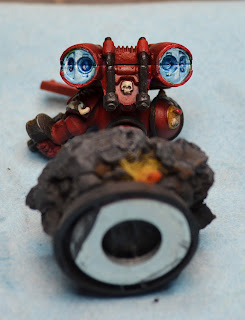1) For the first step I paint the JP thrusters white.
2) Now I use a blue wash in the recesses. It's all about surface tension, you want a really watered down mix. I typically use the GW Asurmen blue and water it down even more, I don't know what the new color is called sry.
3) You want to keep the edges inside of the thruster white. Move the blue around inside keeping it even and adding more blue as needed. Don't go overboard and make sure you keep the paint thin.
4) Basically you just keep adding layers of blue. Once you are happy with the shade you paint white on all the high edges. Thin the white down and only hit the edges. You can dry brush it if you like, if you do, dry brush outward away from the thruster.
That's pretty much it, you just keep working on the color till you're happy with it. I originally started working on a metal Vanguard Vet but released the inside of the thrusters were very rough. It made the process much harder, you might want to clear the inside of the thrusters with a Semi/Gloss to increase the surface tension and allow the paint to run off the edges and sink into the recesses.
I hope this helps and makes sense ..
Here are a few of the pics from the Vanguard Vet ... I had to paint it more than let it run into the cracks itself.










I like it! I'm about to dive into a couple squads of jump troops and I'm definitely going to give this method a try. Might go with yellow rather than blue as the jetpacks themselves will be blue, but the same method should still work well.
ReplyDeleteThanks for the tutorial - keep up the great work!
Thanks ... I'm glad you found it useful! I'm interested in seeing how the yellow turns out 8)
ReplyDelete